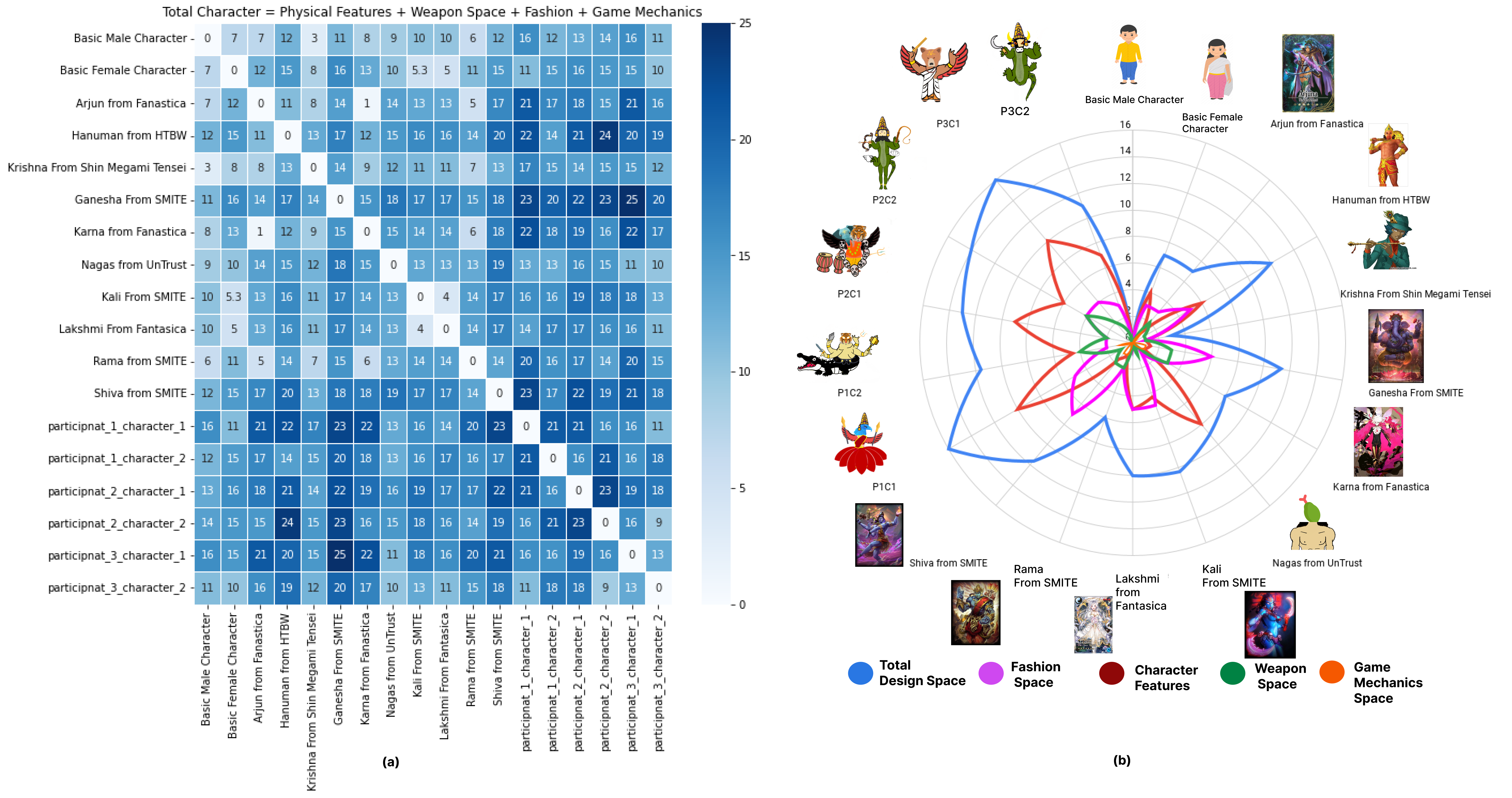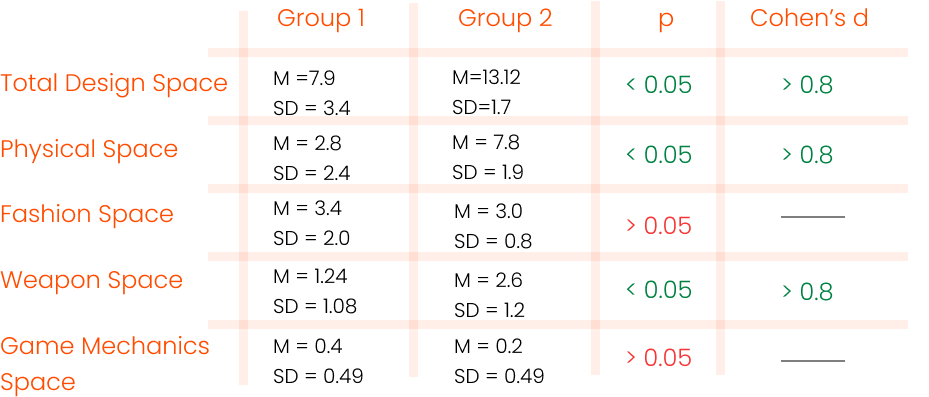AstraVerse
Developing a framework for creating novel and culturally sensitive video game characters inspired by mythology.
.png)
TL;DR: Why This Case Study Matters
How a UX framework enabled ethical, novel character design and addressed a critical industry challenge.
The Problem
- Video games often directly 'transplant' mythological figures.
- This limits creativity and leads to cultural backlash/misrepresentation.
- Designers face "block" finding fresh, respectful inspiration.
My Approach
- Generative: Visual & Digital Ethnography (Hindu temples, Reddit) + Grounded Theory to create a "Syntagm & Paradigm" system.
- Evaluative: Participatory Design (designers), Quantitative Novelty Assessment (vector analysis), Cultural Sensitivity Interviews (experts).
The Solution
- AstraVerse: A card-based design toolkit derived from cultural elements.
- Enables creation of new characters *inspired by*, not *copied from*, mythology.
- Provides structured yet flexible ideation for designers.
Key Results
- Novelty: Characters created were statistically novel (p<0.05, Cohen's d=1.57) compared to transplanted gods.
- Sensitivity: Cultural experts found generated characters acceptable, allowing creative liberty without offense.
- Usability: Designers found the system intuitive and effective for generating creative concepts.
My Role
- Project Lead
- UX Researcher
- System Designer
- Data Analyst & Visualizer
- UX Writer
Team
- 1 Researcher (Myself)
- 1 Artist
- 2 Faculty Advisors
- (Co-authors on paper: J. Pfau, J.B. Dodechani, M. Seif El-Nasr)
Tools & Methods
- Stakeholder Interviews
- Visual & Digital Ethnography
- Grounded Theory
- Participatory Design
- Quantitative Analysis (Python)
- Figma
The Challenge: Inspiring Characters Without Appropriation
Mythology and culture are rich sources of inspiration for video game characters. However, the common practice of directly copying religious or mythological figures—often termed "god transplantation"—presents significant **UX and ethical challenges**. This approach not only limits creative potential by capping the number of available characters but also frequently leads to backlash from cultural communities when sacred figures from active religions are misrepresented or trivialized in games.
This creates a dilemma for game designers: how can they draw inspiration from deep cultural narratives respectfully, while also creating characters that feel fresh, engaging, and appropriate for a global audience? Furthermore, "Designer's block" is a prevalent phenomenon due to the constant need for new game content.
Our goal was to move beyond simple appropriation and explore: How can cultural spaces and elements inform a *process* for designing characters that are both novel and culturally sensitive?
Our Approach: A UX Framework for Cultural Design
We adopted a design thinking framework, combining deep user research with systematic analysis and participatory methods. Our aim was to develop and validate a *system* that empowers designers to generate culturally inspired characters respectfully. This involved a two-step generative process to establish the design space and a three-step evaluative process to validate its efficacy.
Generative Process
- Visual Ethnographic Study: Visiting Hindu places of worship (temples in Sunnyvale, CA) to identify artifacts, mechanics, and characteristics for character creation.
- Grounded Theory: Systematically analyzing collected data (images, observations) using open, axial, and selective coding to identify syntagms (elements) and paradigms (categories), establishing the design space.
Evaluative Process
- Participatory Design Workshop: Validating character creation ability with game designers using the proposed design space.
- Novelty Evaluation: Quantitatively assessing the novelty of created characters against transplanted gods using vector embeddings and distance metrics.
- Cultural Sensitivity Validation: Qualitative interviews with cultural experts (priests, scholars) to assess the cultural appropriateness of generated characters.
The core research question guiding our process was: Can cultural spaces inform the design of Culturally Sensitive and Novel Characters in video games?
Phase 1 (Generative): Empathize & Define via Ethnography
To grasp the complexities and source authentic design elements, we began with understanding the cultural context and stakeholder perspectives.
Visual Ethnography in Cultural Spaces
Researchers visited four Hindu temples in Sunnyvale, California. Photography and videography were permitted, allowing for the collection of rich visual data. One author adopted a researcher-as-participant stance, engaging in activities and rituals to capture events. A total of 429 images were collected, categorized as:
- Images of Idols: 248
- Images of Ongoing Rituals: 63
- Images of Miscellaneous Objects: 45

Initial Stakeholder Perspectives (Pre-System Design)
Early interactions with cultural stakeholders (Hindu temple priests) involved showing them examples of gods used in existing games. This helped us understand their concerns regarding cultural representation even before our design system was conceptualized. (This also informed the later sensitivity evaluation.)

Digital Ethnography: Player Perceptions
We analyzed discussions on gaming-focused Reddit threads to understand player reactions to the use of religious figures in games. This provided insights into player expectations regarding authenticity, respect, and gameplay integration.

Phase 2 (Generative): Ideate - Building the Design System via Grounded Theory
To move beyond "god transplantation," we needed a structured way to identify and organize inspirational cultural elements from the ethnographic data.
Grounded Theory: Developing the "Syntagm & Paradigm" Framework
Using a constructivist Grounded Theory method (GTM), we systematically analyzed the visual data. This iterative coding process (open, axial, and selective coding) transformed raw cultural inspiration into a structured, modular system for creative exploration. Design can be treated as a paradigmatic (set of possible substitutions) and syntagmatic (rules defining structure) process.
- 141 Syntagms (Open Codes): Granular, remixable elements (e.g., specific ornaments, gestures, symbolic items, color palettes).
- 22 Paradigms (Axial Codes): Thematic categories organizing the syntagms (e.g., 'Headwear', 'Handheld Objects', 'Mounts', 'Postures').
- 4 Selective Codes: High-level conceptual pillars guiding character creation:
- Character Features (facial features, limbs, oral cavities, forehead symbolism)
- Weapon Design (ranged, close contact, elemental, mythical, shields, musical)
- Fashion (headgear, jewelry, torso/lower limb clothing, floral elements)
- Game Mechanics (voice, narrative, transportation, residences, gestures - some less visual for characters)

Phase 3 (Generative): Prototype - The AstraVerse Design Toolkit
The "Syntagm and Paradigm" framework was translated into a tangible design tool: a set of cards representing the identified cultural elements. This allows designers to search for specific elements they are looking for, similar to how Character Creation Interfaces (CCIs) in games present structured choices.
How the Toolkit Works:
Designers use the cards as a toolkit:
- Paradigms (Axial Codes / Categories) help navigate the design space.
- Designers select Syntagm cards (Open Codes / Specific Elements) from various Paradigms.
- By combining selected Syntagm cards, designers can visually and conceptually construct new, unique characters rooted in cultural aesthetics but not directly copying existing figures.
.png)
This toolkit prototype aimed to provide a flexible yet structured method for culturally inspired character design.
Phase 4 (Evaluative): Validating the Approach
A design system is only effective if it meets its goals. We conducted a multi-faceted evaluation focusing on our key research questions.

Evaluation 1: Participatory Design Workshop
We invited three game designers from UCSC's Game Design and Development graduate program. They used the AstraVerse card system to create two characters each, tasked with saving a fictional planet. An artist assisted in finalizing the aesthetics.
- Designers found the system intuitive and engaging.
- The cards effectively stimulated creativity and facilitated combining diverse elements.
- The system successfully supported creating coherent character concepts.
.png)
Evaluation 2: Quantitative Analysis
To objectively measure novelty, each character (participant-generated and transplanted gods from games like SMITE) was represented as a vector embedding based on the 141 Syntagms. We used the Canberra distance metric to compare these vectors.
.png)


- Participant-generated characters are statistically novel compared to directly copied gods across the entire design space (Welch's t-test: p<0.05, large effect size Cohen's d=1.57).
- They showed significant novelty in Physical Features (p<0.05, d=1.8), often blending zoomorphic and anthropomorphic traits.
- Differences were also significant in Weapon Design (p<0.05, d=1.1), with more diverse weapon choices.
- Fashion Features and Game Mechanics showed fewer distinctions (p>0.05).
Evaluation 3: Stakeholder Interviews
We interviewed three cultural experts (two Hindu temple priests, one with a diploma in Hindu scriptures). They evaluated participant-generated characters alongside gods transplanted into games (e.g., Kali from SMITE).
"These gods are an identity for lots of us, Devi (Kali) is my primary deity and it is upsetting to see her reduced to such a representation."
"I understand why you would be concerned if game characters can offend people, but I think these [participant-generated characters] are not my gods or any gods that anyone would identify or worship... Items they hold might have cultural value, but as creatures, I am not worried about what they do, or what happens to the character... The reason I might be okay with it is, it does not touch the source gods."
- Participant-generated characters were received positively. Stakeholders reiterated strong objections to using original gods directly, especially when narratives deviate.
- They recognized mythological elements but perceived generated characters as fictional creations *inspired by*, not copies *of*, mythology.
- Crucially, stakeholders felt creative liberty *could* be taken with narratives for these fictional characters, unlike for original sacred figures.
Key Outcomes & Impact
Summary of Impact:
- Culturally Sensitive Creations: Generated characters were perceived by cultural experts as unique, fictional beings *inspired by* mythology rather than direct, potentially offensive copies. This allowed for creative narratives without cultural backlash.
- Measurable Novelty: Statistical analysis confirmed that characters created with AstraVerse are significantly more novel (distinct) than traditional "god transplantation" methods, particularly in physical features and weapon design.
- Empowered Designers: Game designers found the card-based toolkit intuitive and effective, stimulating creativity and providing a structured pathway to overcome ideation challenges.
Conclusion & Implications
The AstraVerse project successfully demonstrated that it's possible to move beyond direct appropriation in culturally inspired character design. Through a rigorous UX research and design process, we developed and validated a system using syntagms and paradigms that:
- Provides designers with a structured yet flexible tool for creative exploration grounded in cultural aesthetics.
- Enables the generation of characters perceived as statistically novel and visually unique compared to existing transplanted figures.
- Produces character concepts deemed culturally sensitive and acceptable by cultural stakeholders.
This framework offers a practical, validated alternative for game studios and designers seeking to draw inspiration from diverse cultures respectfully. It fosters creativity while mitigating risks of cultural misrepresentation and provides a method to overcome "designer's block." This work opens discussions for further research on culture and avatar creation using UX methods.
Personal Learnings & Future Work
Key Learnings
- Bridging Research & Design: Translating academic methods like Grounded Theory into a practical design tool (syntagms/paradigms) is effective for designers.
- Power of Mixed Methods: Combining qualitative insights (interviews, ethnography) with quantitative validation (statistical analysis) creates a robust case.
- Navigating Sensitivity: Early and respectful engagement with cultural stakeholders is crucial for accurate problem definition and appropriate solutions.
- Systemic > Specific: A reusable *system* offers broader, lasting value over isolated designs.
Limitations and Future Work
- Weighted Embeddings: Future work could assign different weights to design elements in vector calculations (e.g., facial features vs. jewelry).
- Meta-data for Elements: Incorporate meta-data (e.g., color differences) for more accurate character representations.
- Designer Experience Study: Conduct A/B testing to understand the design space's effectiveness in overcoming designer's block and learn about their experience.
- Cross-Cultural Exploration: Explore other cultural sites and the potential for merging design spaces.